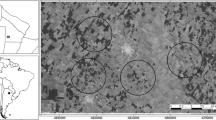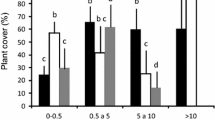Abstract
This is the first study to investigate whether scatter-hoarding behavior, a conditional mutualism, can be disrupted by forest fragmentation. We examined whether acouchies (Myoprocta acouchy, Rodentia) and agoutis (Dasyprocta leporina, Rodentia) changed scatter-hoarding behavior toward seeds of Astrocaryum aculeatum (Arecaceae) as a consequence of a decrease in forest-patch area. Our study was conducted at the 30-year-old Biological Dynamics of Forest Fragments Project, in central Amazon, Brazil. We tested whether forest size affected the number of Astrocaryum seeds removed and scatter-hoarded (and likely dispersed) by acouchies and agoutis, as well as the distance that the seeds were hoarded. The study extended over three seasons: the peak of the rainy season (March–April), the transition between the rainy and the dry season (May–June), and the peak of the dry season (August–September). Our results revealed that the number of seeds removed was larger in smaller fragments, but that the percentage of seeds hoarded was much lower, and seeds eaten much higher, in 1-ha fragments. Moreover, fewer seeds were taken longer distances in fragments than in the continuous forest. Site affected the number of seeds removed and season affected the percentage of seeds hoarded: more seeds were removed from stations in one site than in two others, and hoarding was more important in April and September than in June. Our study reveals that scatter-hoarding behavior is affected by forest fragmentation, with the most important disruption in very small fragments. Fragmentation converts a largely mutualistic relationship between the rodents and this palm in large forest patches into seed predation in small fragments.



Similar content being viewed by others
References
Achard F, Eva HD, Stibig HJ, Mayaux P, Gallego J, Richards T, Malingreau JP (2002) Determination of deforestation rates of the world’s humid tropical forests. Science 297:999–1002
Agresti A (1996) An introduction to categorical data analysis. Wiley, New York
Asquith NM, Terborgh J, Arnold AE, Riveros CM (1999) The fruits the agouti ate: Hymenaea courbaril seed fate when its disperser is absent. J Trop Ecol 15:229–235
Bierregaard RO, Gascon C, Lovejoy TE, Mesquita RCG (2001) Lessons from Amazonia: the ecology and conservation of a fragmented forest. Yale University Press, New Haven
Bronstein JL (1994) Conditional outcomes in mutualistic interactions. Trends Ecol Evol 9:214–217
Cordeiro NJ, Howe HF (2003) Forest fragmentation severs mutualism between seed dispersers and an endemic African tree. Proc Natl Acad Sci USA 100:14052–14056
Cramer JM, Mesquita RCG, Williamson GB (2007) Forest fragmentation differentially affects seed dispersal of large and small-seeded tropical trees. Biol Conserv 137:415–423
Dubost G (1988) Ecology and social-life of the red acouchy, Myoprocta exilis—comparison with the orange-rumped Agouti, Dasyprocta leporina. J Zool 214:107–123
Dubost G, Henry O (2006) Comparison of diets of the acouchy, agouti and paca, the three largest terrestrial rodents of French Guianan forests. J Trop Ecol 22:641–651
Forget PM (1991) Scatterhoarding of Astrocaryum paramaca by Proechimys in French Guiana: comparison with Myoprocta exilis. Trop Ecol 32:155–167
Forget PM (1992) Seed removal and seed fate in Gustavia superba (Lecythidaceae). Biotropica 24:408–414
Forget PM (1993) Postdispersal predation and scatterhoarding of Dipteryx panamensis (Papilionaceae) seeds by rodents in Panama. Oecologia 94:255–261
Forget PM, Milleron T (1991) Evidence for secondary seed dispersal by rodents in Panama. Oecologia 87:596–599
Forget PM, Hammond DS, Milleron T, Thomas R (2002) Seasonality of fruiting and food hoarding by rodents in Neotropical forests: consequences for seed dispersal and seedling recruitment. In: Levey DJ, Silva WR, Galetti M (eds) Seed dispersal and frugivory: ecology, evolution and conservation, vol 1. CABI, New York, pp 241–266
Foster RB (1982) The seasonal rhythm of fruitfall on Barro Colorado Island. In: Leigh EG, Rand AS, Windsor DM (eds) The ecology of a tropical rainforest: seasonal rhythms and long-term changes. Smithsonian Institution Press, Washington, DC, pp 151–172
Galetti M, Donatti CI, Pires AS, Guimaraes PR, Jordano P (2006) Seed survival and dispersal of an endemic Atlantic forest palm: the combined effects of defaunation and forest fragmentation. Bot J Linn Soc 151:141–149
Gilbert LE (1980) Food web organization and the conservation of Neotropical diversity. In: Soulé ME, Wilcox BA (eds) Conservation biology: an evolutionary-ecological perspective. Sinauer, Sunderland, pp 11–33
Guariguata MR, Arias-Le Claire H, Jones G (2002) Tree seed fate in a logged and fragmented forest landscape, northeastern Costa Rica. Biotropica 34:405–415
Hansen MC, DeFries RS (2004) Detecting long-term global forest change using continuous fields of tree-cover maps from 8-km advanced very high resolution radiometer (AVHRR) data for the years 1982–99. Ecosystems 7:695–716
Henderson A, Galeano G, Bernal R (1995) Field guide to the palms of the Americas. Princeton University Press, Princeton
Howe HF, Smallwood J (1982) Ecology of seed dispersal. Annu Rev Ecol Syst 13:201–228
Howe HF, Vande Kerckhove GA (1980) Nutmeg dispersal by tropical birds. Science 210:925–927
Janzen DH (1969) Seed-eaters versus seed size, toxicity and dispersal. Evolution 23(1):1–27
Jorge MLSP (2007) Scatter-hoarding behavior of two amazonian rodents: theory and application in forest fragments. In: Department of Biological Sciences. University of Illinois at Chicago, Chicago, p 139
Jorge MLSP (2008) Effects of forest fragmentation on two sister genera of Amazonian rodents (Myoprocta acouchy and Dasyprocta leporina). Biol Conserv 141:617–623
Jorge MSP, Peres CA (2005) Population density and home range use of red-rumped agoutis (Dasyprocta leporina) within and outside a natural Brazil nut stand in south-eastern Amazonia. Biotropica 37:317–321
Kawn F, Granville J (1992) Palms in forest ecosystems of Amazonia. Springer, Heidelberg
Laurance WF, Bierregaard RO (1997) Tropical forest remnants: ecology management and conservation of fragmented communities. The University of Chicago Press, Chicago
Lawton JH (1999) Are there general laws in ecology? Oikos 84:177–192
Leishman MR, Westoby M (1994) The role of large seed size in shaded conditions—experimental-evidence. Funct Ecol 8:205–214
Manasse RS, Howe HF (1983) Competition for dispersal agents among tropical trees influences of neighbors. Oecologia 59:185–190
Moles AT et al (2007) Global patterns in seed size. Glob Ecol Biogeogr 16:109–116
Morris DW (1962) The behaviour of the green acouchi (Myoprocta pratti) with special reference to scatter hoarding. Proc Zool Soc Lond 139:701–733
Pesce C (1985) Oil palms and other oil seeds of the Amazon. Algonac, Michigan
Pringle EG, Alvarez-Loayza P, Terborgh J (2007) Seed characteristics and susceptibility to pathogen attack in tree seeds of the Peruvian Amazon. Plant Ecol 193:211–222
Schupp EW (1993) Quantity, quality and the effectiveness of seed dispersal by animals. Vegetatio 108:15–29
Silvius KM, Fragoso JMV (2003) Red-rumped agouti (Dasyprocta leporina) home range use in an Amazonian forest: implications for the aggregated distribution of forest trees. Biotropica 35:74–83
Smythe N (1978) The natural history of the Central American agouti (Dasyprocta punctata). Smithson Contrib Zool 257:1–52
Smythe N (1989) Seed survival in the palm Astrocaryum standleyanum—evidence for dependence upon its seed dispersers. Biotropica 21:50–56
Terborgh J, Losos E, Riley MP, Riley MB (1993) Predation by vertebrates and invertebrates on the seeds of 5 canopy tree species of an Amazonian forest. Vegetatio 108:375–386
Theimer TC (2005) Rodent scatterhoarders as conditional mutualists. In: Forget P-M, Lambert JE, Hulme PE, Vander Wall SB (eds) Seed fate. CAB International, Wallingford, pp 283–295
Uhl C, Dransfield J (1987) Genera Palmarum. Allen, Lawrence
Vander Wall SB (1990) Food hoarding in animals. University of Chicago Press, Chicago
Vander Wall SB (2002) Masting in animal-dispersed pines facilitates seed dispersal. Ecology 83(12):3508–3516
Voss RS, Emmons LH (1996) Mammalian diversity in neotropical lowland rainforests: a preliminary assessment. Bull Am Mus Nat Hist 230:3–115
Westoby M, Leishman M, Lord J (1996) Comparative ecology of seed size and dispersal. Phil Trans R Soc Lond B Biol Sci 351:1309–1317
Wright SJ, Duber HC (2001) Poachers and forest fragmentation alter seed dispersal, seed survival, and seedling recruitment in the palm Attalea butyraceae, with implications for tropical tree diversity. Biotropica 33:583–595
Wright SJ, Carasco C, Calderon O, Paton C (1999) The El Nino Southern Oscillation, variable fruit production, and famine in a tropical forest. Ecology 80:1632–1647
Zar JH (1999) Biostatistical analysis, 4th edn. Prentice Hall, New Jersey
Acknowledgments
We thank M. L. Dourado, S. M. Souza, A. M. dos Reis and O. F. da Silva, for invaluable field assistance. Significant comments were provided by Dr J. Brown, Dr R. Foster, Dr B. Patterson, Dr C. Whelan, Dr P. Banks, Dr T. Theimer, and one anonymous reviewer. This work was funded by the Conselho Nacional de Desenvolvimento Científico e Tecnológico, the BDFFP and the University of Illinois at Chicago. This is publication no. 531 in the BDFFP technical series. Our experiments comply with the laws in Brazil. M. L. S. P. J. was supported by CNPq with a Ph.D. scholarship and H. F. H. was supported by NSF grants DEB 012908 and 0516259 during the course of this study.
Author information
Authors and Affiliations
Corresponding author
Additional information
Communicated by Peter Banks.
Rights and permissions
About this article
Cite this article
Jorge, M.L.S.P., Howe, H.F. Can forest fragmentation disrupt a conditional mutualism? A case from central Amazon. Oecologia 161, 709–718 (2009). https://doi.org/10.1007/s00442-009-1417-7
Received:
Accepted:
Published:
Issue Date:
DOI: https://doi.org/10.1007/s00442-009-1417-7




